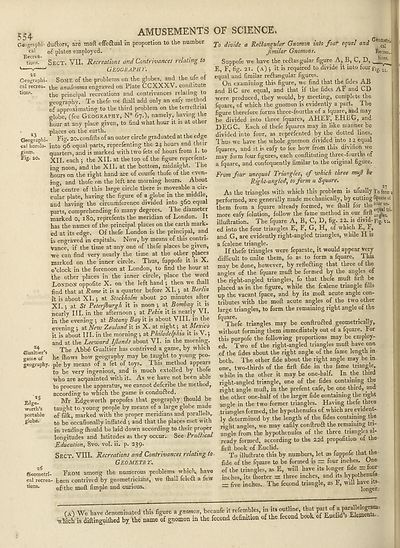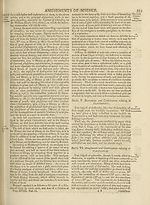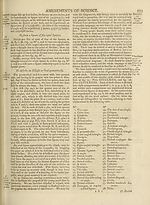Encyclopaedia Britannica, or, a Dictionary of arts, sciences, and miscellaneous literature : enlarged and improved. Illustrated with nearly six hundred engravings > Volume 18, RHI-SCR
(576) Page 554
Download files
Complete book:
Individual page:
Thumbnail gallery: Grid view | List view

554-
Geographi
cal
llecrea-
tlons.
12
Geographi¬
cal recrea¬
tions.
AMUSEMENTS OF SCIENCE.
>3 .
Geographi¬
cal horolo¬
gium.
Fig. ao.
24
Gualtier’s
game of
geography,
'■*5
Edge-
worth’s
portable
globe.
aS
Geometri¬
cal recrea¬
tions-
duftors, are moft effe&ual in proportion to the number
of plates employed.
Sect. VII. Recreations and Contrivances relating to
J Geograput.
Some of the problems on the globes, and the ufe of
the analemma engraved on Plate CCXXXV. conftitute
the principal recreations and contrivances relating to
geography. To thefe we {hall add only an eafy method
of approximating to the third problem on the terreftrial
globe, (fee Geography, N° 67.), namely, having the
hour at any place given, to find what hour it is at other
places on the earth.
FK 20. confifts of an outer circle graduated at the edge
into 96 equal parts, reprefenting the 24 hours and their
quarters, and is marked with two fets of hours from I. to
XII. each $ the XII. at the top of the figure reprefent¬
ing noon, and the XII. at the bottom, midnight. The
hours on the right hand are of courfe thofe of the even¬
ing, and thofe on the left are morning hours. About
the centre of this large circle there is moveable a cir¬
cular plate, having the figure of a globe in the middle,
and having the circumference divided into 360 equal
parts, comprehending fo many degrees. 1 he diameter
marked O, 180, reprefents the meridian of London. It
has the names of the principal places on the earth mark¬
ed at its edge. Of thefe London is the principal, and
is engraved in capitals. Now, by means of this contri¬
vance, if the time at any one of thefe places be given,
■we can find very nearly the time at the other places
marked on the inner circle. Thus, fuppofe it is X.
o’clock in the forenoon at London, to find the hour at
the other places in the inner circle, place the word
London oppofite X. on the left hand ; then we {hall
find that at Rome it is a quarter before XI. •, at Berlin
it is about XL j at Stockholm about 20 minutes after
XL*, at St Peterjburgh it is noon-, at Bombay it is
nearly III. in the afternoon -, at Pekin it is nearly VI.
in the evening j at Botany Bay it is about VIII. in the
evening j at New Zealand it is X. at night at Mexico
it is about III. in the morning -, at Philadelphia it is V;
and at the Leeward IJlands about VI. in the morning.
The Abbe Gualtier has contrived a game, by which
he (hows how geography may be taught to young peo¬
ple by means of a fet of toys. This method appears
to be very ingenious, and is much extolled by thofe
who are acquainted with it. As we have not been able
to procure the apparatus, we cannot defcribe the method,
according to which the game is conduced.
IVIr Edgeworth propofes that geography fhould be
taught to.young people by means of a large globe made
of filk, marked with the proper meridians and parallels,,
to be occafionally inflated ; and that the places met with
in reading fhould be laid down according to their proper
longitudes and latitudes as they occur. See Pra&ical
Education, 8vo. vol. ii. p. 239.
Sect. VIII. Recreations and Contrivances relating to
Geometry.
From among the numerous problems which, have
been contrived by geometricians, we fhall fele£t a few
of*the moft Ample and curious..
To divide a Red angular Gnomon into four equal and Geo*Jri'
Recrea..
tions.
jimilar Gnomons.
Suppofe we have the rectangular figure A, B, C, D, ^
E, F, fig. 2i. (a) j it is required to divide it into four FigTiT''
equal and fimilar rectangular figures.
On examining this figure, we find that the fides AB
and BC are equal, and that if the fides AF and CD
were produced, they would, by meeting, complete the
fquare, of which the gnomon is evidently a part. The
figure therefore forms three-fourths of a fquare, and may
be divided into three Iquares, AHEF, EFtLG, and
DEGC. Each of thefe fquares may in like manner be
divided into four, as reprefented by the dotted lines.
Thus we have the whole gnomon divided into 12 equal
fquares, and it is eafy to fee how from this divifion we
may form four figures, each conftituting three-fourths of
a fquare, and confequently fimilar to the original figure.
From four unequal Triangles, of which three mujl be
Right-angled, to form a Square.
27
As the triangles with which this problem is ufually To form ,
performed, are generally made mechanically, by cutting%are of 1
them from a fquare already formed, we fhall for the i
more eafy lolution, follow the fame method in our. firft ari^eSi
illuftration. The fquare A, B, C, D, fig. 22. is divid-fig. ;i,
ed into the four triangles E, F, G, H, of which E, F,
and G, are evidently right-angled triangles, while H is
a fcalene triangle.
If thefe triangles were feparate, it would appear very
difficult to unite them, fo as to form a fquare. This
may be done, however, by reflefting that three of the
angles of the fquare muft be formed by the angles of
the right-angled triangles, fo that thefe muft firft be
placed as in the figure, while the fcalene triangle fills
up the vacant fpace, and by its moft acute angle con¬
tributes with the moft acute angles of the two other
large triangles, to form the remaining right angle of the
fquare.
Thefe triangles may be conftrufted geometrically,
without forming them immediately out of a fquare. For
this purpofe the following proportions may be employ¬
ed. Two of the right-angled triangles muft have one
of the fides about the right angle of the fame length in
both. The other fide about the right angle may be in
one, two-thirds of the firft fide in the fame triangle,
while in the other it may be one-half. In the third
right-angled triangle, one of the fides containing the
right angle, muft, in the prefent cafe, be one third, and
the other one-half of the larger fide containing the right
angle in the two former triangles. Having thefe three
triangles formed, the hypothenufes of which are evident¬
ly determined by the length of the fides containing the
right angles, we may eafily conftruCt the remaining tri¬
angle from the hypothenufes of the three triangles al¬
ready formed, according to the 22d propofition of the^
fir ft book of Euclid.
To illuftrate this by numbers, let us fuppofe that the
fide of the fquare to be formed is = four inches. One
of the triangles, as E, will have its longer fide _ four
inches, its fhorter = three inches, and its hypothenuie
= five inches. The fecond triangle, as F, will have its-
longer
(a) We have denominated this figure a fmm'm, becaufe it refembles, in its outline, that
,4ch is diftinguiihed by the name of gnomon in the fecond definttton of the fecond book of Euclid s Elements..
Geographi
cal
llecrea-
tlons.
12
Geographi¬
cal recrea¬
tions.
AMUSEMENTS OF SCIENCE.
>3 .
Geographi¬
cal horolo¬
gium.
Fig. ao.
24
Gualtier’s
game of
geography,
'■*5
Edge-
worth’s
portable
globe.
aS
Geometri¬
cal recrea¬
tions-
duftors, are moft effe&ual in proportion to the number
of plates employed.
Sect. VII. Recreations and Contrivances relating to
J Geograput.
Some of the problems on the globes, and the ufe of
the analemma engraved on Plate CCXXXV. conftitute
the principal recreations and contrivances relating to
geography. To thefe we {hall add only an eafy method
of approximating to the third problem on the terreftrial
globe, (fee Geography, N° 67.), namely, having the
hour at any place given, to find what hour it is at other
places on the earth.
FK 20. confifts of an outer circle graduated at the edge
into 96 equal parts, reprefenting the 24 hours and their
quarters, and is marked with two fets of hours from I. to
XII. each $ the XII. at the top of the figure reprefent¬
ing noon, and the XII. at the bottom, midnight. The
hours on the right hand are of courfe thofe of the even¬
ing, and thofe on the left are morning hours. About
the centre of this large circle there is moveable a cir¬
cular plate, having the figure of a globe in the middle,
and having the circumference divided into 360 equal
parts, comprehending fo many degrees. 1 he diameter
marked O, 180, reprefents the meridian of London. It
has the names of the principal places on the earth mark¬
ed at its edge. Of thefe London is the principal, and
is engraved in capitals. Now, by means of this contri¬
vance, if the time at any one of thefe places be given,
■we can find very nearly the time at the other places
marked on the inner circle. Thus, fuppofe it is X.
o’clock in the forenoon at London, to find the hour at
the other places in the inner circle, place the word
London oppofite X. on the left hand ; then we {hall
find that at Rome it is a quarter before XI. •, at Berlin
it is about XL j at Stockholm about 20 minutes after
XL*, at St Peterjburgh it is noon-, at Bombay it is
nearly III. in the afternoon -, at Pekin it is nearly VI.
in the evening j at Botany Bay it is about VIII. in the
evening j at New Zealand it is X. at night at Mexico
it is about III. in the morning -, at Philadelphia it is V;
and at the Leeward IJlands about VI. in the morning.
The Abbe Gualtier has contrived a game, by which
he (hows how geography may be taught to young peo¬
ple by means of a fet of toys. This method appears
to be very ingenious, and is much extolled by thofe
who are acquainted with it. As we have not been able
to procure the apparatus, we cannot defcribe the method,
according to which the game is conduced.
IVIr Edgeworth propofes that geography fhould be
taught to.young people by means of a large globe made
of filk, marked with the proper meridians and parallels,,
to be occafionally inflated ; and that the places met with
in reading fhould be laid down according to their proper
longitudes and latitudes as they occur. See Pra&ical
Education, 8vo. vol. ii. p. 239.
Sect. VIII. Recreations and Contrivances relating to
Geometry.
From among the numerous problems which, have
been contrived by geometricians, we fhall fele£t a few
of*the moft Ample and curious..
To divide a Red angular Gnomon into four equal and Geo*Jri'
Recrea..
tions.
jimilar Gnomons.
Suppofe we have the rectangular figure A, B, C, D, ^
E, F, fig. 2i. (a) j it is required to divide it into four FigTiT''
equal and fimilar rectangular figures.
On examining this figure, we find that the fides AB
and BC are equal, and that if the fides AF and CD
were produced, they would, by meeting, complete the
fquare, of which the gnomon is evidently a part. The
figure therefore forms three-fourths of a fquare, and may
be divided into three Iquares, AHEF, EFtLG, and
DEGC. Each of thefe fquares may in like manner be
divided into four, as reprefented by the dotted lines.
Thus we have the whole gnomon divided into 12 equal
fquares, and it is eafy to fee how from this divifion we
may form four figures, each conftituting three-fourths of
a fquare, and confequently fimilar to the original figure.
From four unequal Triangles, of which three mujl be
Right-angled, to form a Square.
27
As the triangles with which this problem is ufually To form ,
performed, are generally made mechanically, by cutting%are of 1
them from a fquare already formed, we fhall for the i
more eafy lolution, follow the fame method in our. firft ari^eSi
illuftration. The fquare A, B, C, D, fig. 22. is divid-fig. ;i,
ed into the four triangles E, F, G, H, of which E, F,
and G, are evidently right-angled triangles, while H is
a fcalene triangle.
If thefe triangles were feparate, it would appear very
difficult to unite them, fo as to form a fquare. This
may be done, however, by reflefting that three of the
angles of the fquare muft be formed by the angles of
the right-angled triangles, fo that thefe muft firft be
placed as in the figure, while the fcalene triangle fills
up the vacant fpace, and by its moft acute angle con¬
tributes with the moft acute angles of the two other
large triangles, to form the remaining right angle of the
fquare.
Thefe triangles may be conftrufted geometrically,
without forming them immediately out of a fquare. For
this purpofe the following proportions may be employ¬
ed. Two of the right-angled triangles muft have one
of the fides about the right angle of the fame length in
both. The other fide about the right angle may be in
one, two-thirds of the firft fide in the fame triangle,
while in the other it may be one-half. In the third
right-angled triangle, one of the fides containing the
right angle, muft, in the prefent cafe, be one third, and
the other one-half of the larger fide containing the right
angle in the two former triangles. Having thefe three
triangles formed, the hypothenufes of which are evident¬
ly determined by the length of the fides containing the
right angles, we may eafily conftruCt the remaining tri¬
angle from the hypothenufes of the three triangles al¬
ready formed, according to the 22d propofition of the^
fir ft book of Euclid.
To illuftrate this by numbers, let us fuppofe that the
fide of the fquare to be formed is = four inches. One
of the triangles, as E, will have its longer fide _ four
inches, its fhorter = three inches, and its hypothenuie
= five inches. The fecond triangle, as F, will have its-
longer
(a) We have denominated this figure a fmm'm, becaufe it refembles, in its outline, that
,4ch is diftinguiihed by the name of gnomon in the fecond definttton of the fecond book of Euclid s Elements..
Set display mode to:
![]() Universal Viewer |
Universal Viewer | ![]() Mirador |
Large image | Transcription
Mirador |
Large image | Transcription
Images and transcriptions on this page, including medium image downloads, may be used under the Creative Commons Attribution 4.0 International Licence unless otherwise stated. ![]()
| Permanent URL | https://digital.nls.uk/193026195 |
|---|
| Attribution and copyright: |
|
|---|
| Description | Ten editions of 'Encyclopaedia Britannica', issued from 1768-1903, in 231 volumes. Originally issued in 100 weekly parts (3 volumes) between 1768 and 1771 by publishers: Colin Macfarquhar and Andrew Bell (Edinburgh); editor: William Smellie: engraver: Andrew Bell. Expanded editions in the 19th century featured more volumes and contributions from leading experts in their fields. Managed and published in Edinburgh up to the 9th edition (25 volumes, from 1875-1889); the 10th edition (1902-1903) re-issued the 9th edition, with 11 supplementary volumes. |
|---|---|
| Additional NLS resources: |
|

